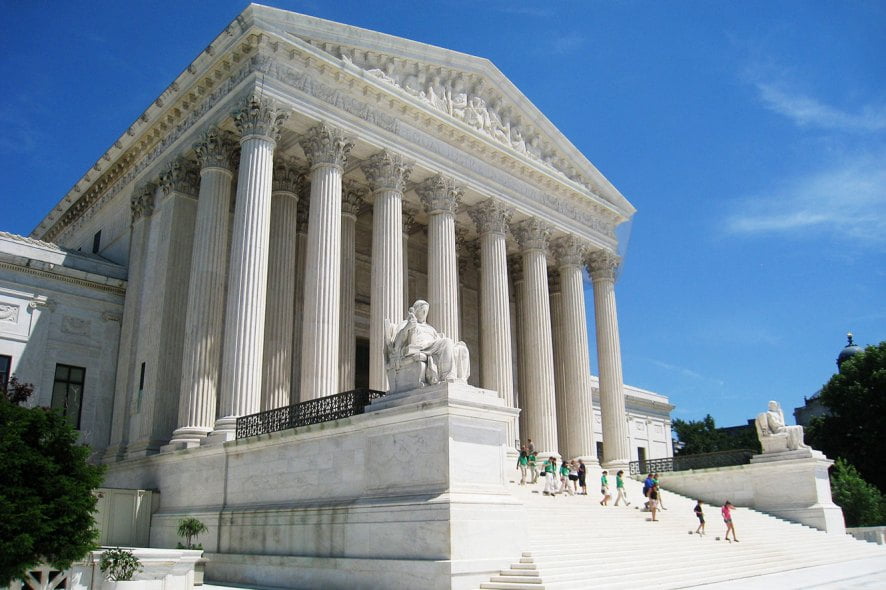

Supreme Court of the United States (SCOTUS): In the instant matter, the SCOTUS deliberated upon a Redistricting Plan prepared by the Governor of Wisconsin for seats in the State’s legislature- the plan which was adopted by Wisconsin Supreme Court and would have increased the number of majority-Black districts in the Wisconsin State Assembly from six to seven. The 9- Judge Bench of the Court comprising, John Roberts, C.J., and Clarence Thoms, Stephen Breyer, Samuel Alito, Sonia Sotomayor, Elena Kagan, Neil Gorsuch, Brett Kavanaugh and Amy Coney Barrett, JJ., with a ratio of 7:2, reversed the imposition of the Governor’s State Assembly and Senate maps stating that the court committed legal error in its application of SCOTUS precedents regarding the relationship between the constitutional guarantee of equal protection and the Voting Rights Act (hereinafter VRA). The issue was remanded to the Wisconsin Supreme Court for proceedings not inconsistent with the opinion expressed by the SCOTUS. Justices Sonia Sotomayor and Elena Kagan expressed their dissent over the issue.
Background and Legal Trajectory of the case: After the conduction of decennial census in the year 2020, it was revealed that due to population shifts, Wisconsin’s State Assembly and Senate districts were not equally apportioned anymore. In order to rectify this situation, the Wisconsin Legislature passed new maps, but the Governor vetoed them. At an impasse, the legislature and the Governor turned to the Wisconsin Supreme Court. Instead of attempting to draw new maps itself, the court invited the parties and intervenors; including the Legislature and the Governor, to propose maps that complied with the State Constitution, the Federal Constitution, and the Voting Rights Act, 1965.
On 3rd March, 2022, the Wisconsin SC issued a decision selecting the Assembly and Senate maps that the Governor had proposed. The Governor’s Assembly map intentionally created seven majority-Black districts by reducing the Black voting-age population in the other six majority-Black districts.
The Wisconsin SC concluded that the Governor’s map complied with the Equal Protection Clause of the Fourteenth Amendment because there were “good reasons” to think that the VRA “may” require the additional majority-Black district.
Contentions: The Governor of Wisconsin had justified the addition of a 7th majority –Black district citing the necessity for compliance with the VRA.
Per contra, the legislature and the voters who now seek relief from the aforementioned decision, argued that the court selected race-based maps without sufficient justification, in violation of the Equal Protection Clause. Thus, they filed the instant application before the SCOTUS to either to grant an emergency stay or to construe their application as a petition for certiorari and reverse the decision of Wisconsin SC.
Observations by the Majority: The Majority, while agreeing with the contention raised by the applicants, opined that the Wisconsin SC committed a legal error while deciding the issue. Noting that the Equal Protection Clause terms the sorting of voters on the basis of race as “odious”, the Majority stated that that if race is the predominant factor motivating the placement of voters in or out of a particular district, then, the State bears the burden of showing that the design of that district withstands strict scrutiny- “Our precedents hold that a State can satisfy strict scrutiny if it proves that its race-based sorting of voters is narrowly tailored to comply with the VRA”. Citing SCOTUS’ decision in Thornburg v. Gingles, 1986 SCC OnLine US SC 170 and Cooper v. Harris, 2017 SCC OnLine US SC 23, the Majority noted that when a State invokes S. 2 of VRA to justify race-based districting, the State must show that it had ‘a strong basis in evidence’ for concluding that the statute required its action. The Court also observed that the pre-conditions laid down in Gingles case must be satisfied for such districting. The Majority also noted that Cooper’s strict-scrutiny test regarding the requirements of Equal Protection Clause must be satisfied as well.
The Majority also pointed out that there was not clarity that whether the Wisconsin viewed the Governor or itself as the state mapmaker who must satisfy strict scrutiny. They further observed that the Wisconsin SC failed to answer that whether a race-neutral alternative that did not add a seventh majority-black district would deny Black voters equal political opportunity. “When the Wisconsin Supreme Court endeavored to undertake a full strict-scrutiny analysis, it did not do so properly under our precedents, and its judgment cannot stand”.
The Dissent: Sonia Sotomayor, J., (joined by Elena Kagan, J.) termed the decision of the Majority as “unprecedented” and the SCOTUS’ intervention in the matter as “extraordinary and unnecessary”. She observed that the Majority’s decision is based on assuming the answers to multiple questions that precedents themselves left uncertain. She noted that “The Wisconsin SC accepted an original action to supervise the redistricting and, with the input of the parties, design edits own process for doing so: accepting proposed maps from litigants rather than “crafting its own map” and determining to choose the maps that best conformed with its directives.”
Observing that the Majority took Wisconsin SC to task for not following the directives of Gingles case, Justice Sotomayor stated that courts generally are not mandated to investigate undisputed and non-jurisdictional issues. She further noted that the Majority did not point out to any precedent requiring a court conducting a malapportionment analysis to embark on an independent inquiry into matters that the parties have conceded or not contested, like the Gingles preconditions.
[“source=scconline”]

